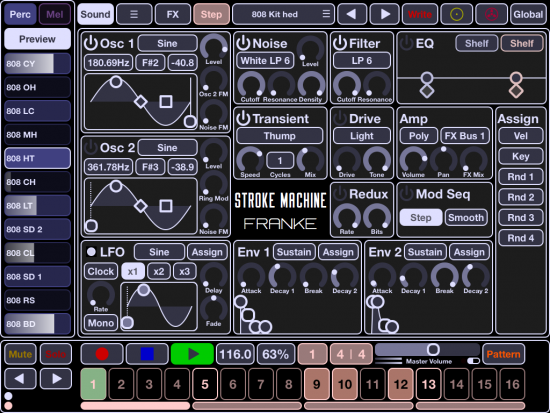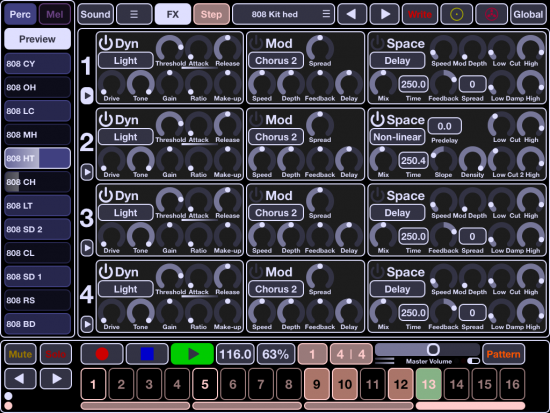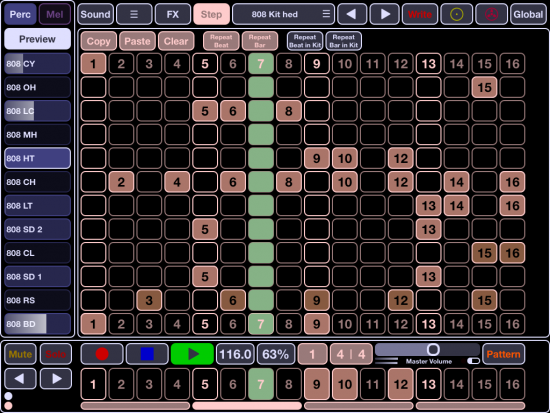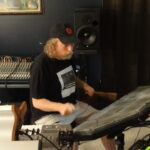When I reviewed Waldorf’s excellent Nave iPad synth app, I remarked that the company needs to release an iOS version of its very cool Attack drum machine plug-in. Stroke Machine, created by former Waldorf man, Wolfram Franke, is just that app. A very detailed and powerful beatmaker with a host of interesting features — including the ability to program your own sounds — Stroke Machine ranks with DM1 at the top of the iPad drum machine scene.
Stroke Machine for the iPad Features
- Drum Machine with Synth Programming Features
- Patterns with 12 Drum Voices and 12 Melodic Voices
- Sample Importing
- Each Voice with Two Oscillators, Ring Modulation, FM, and More
- White and Pink Noise Generator, Transient Generator
- LFO, Filter, 4 Bus Multi-effects
- Rich Library of Sounds, Kits, and Patterns
- Support for Inter App Audio, Audiobus, and WIST
- Available at the App Store for $19.99
Stroke Machine is a must for anyone looking to build their own drum machine patterns from the sound programming upwards. The well-written and detailed manual is another great feature — and necessary as this is a detailed app! A robust amount of functionality and fun fits on an iPad screen.
Breaking Down the Stroke Machine Architecture
Featuring an almost garish color scheme (optimized for rave viewing) that can be toned down in the options, Stroke Machine’s interface is very functional. All the necessary synth parameters fit on one screen, with a transport bar located at the bottom of the app. A vertical menu bar on the left of the app gives access to each voice (or part in the app’s nomenclature) in a pattern; they can be easily soloed or muted as necessary.

Stroke Machine features a robust synth engine, optimized for drum beat creation. Note: This is the subdued color scheme. Screenshot by Author.
All saved patterns, kits, and sounds are easily accessible from the app’s menu interface. Stroke Machine treats patterns and kits interchangeably. As the manual states: “a Pattern is a Kit is a Pattern.” Indeed.
An “Ableton Live” style is used for the synth knobs, switches, and sliders. Graphic displays in the app feature convenient handles to allow for easy touchscreen editing. The range of parameters in sound creation rival most iPad synth apps, let alone small iOS drum machine world.
Sound creation in Stroke Machine is a blast. Throwing in some FM and/or ring modulation is a breeze, and when combined with noise and variety of transients, it opens up a sonic world of percussion creativity — melodic sounds too. Filters, a drive stage, a decimator, EQ, a detailed LFO, two envelopes, and a modulation matrix — with most controls automatable — round out this rich, rich synthesizer engine. Sounds can be saved separately from a Pattern/Kit and used in other Kit/Patterns.
Wait, there are four effects busses. Each bus includes two dynamic effects, a modulation effect (chorus, flanger, etc.), and space effect (reverbs and delays). Each sound is separately assigned to one of the four busses.
Pattern writing takes place on a step sequencer screen with both beat and note entry; the latter being used for melodic sounds. A swing percentage and the tempo are modified on the transport menu.
Stroke Machine allows for some time signature tweaking, but not enough for me. You can do variations of 2, 3, or 4 notes per measure (including 9/8), but 5/4, 5/8, 7/8, 11/8 need to be added in a future update. Being able to enter actual time signatures as well would be more intuitive than the current method, which involves entering beats per bar and steps per beat separately with both limited to a range of 1 to 4.
Support for the iPad audio standards — Audiobus, Inter App Audio, WIST, etc. — finishes off this incredibly deep drum machine app.
Stroke Machine thrives on newer iPads
With such a detailed synth engine, Stroke Machine stretches the capabilities of my iPad 2. Setting the audio buffer size to 1024 samples definitely helps. The latest version of the app (1.03) greatly improved its stability, as it would freeze pretty regularly beforehand and still occasionally drops a sound during beat playback — the latter does lead to interesting pattern variations.
Wolfram Franke is very responsive, so expect things to get better with each successive release. Still, Stroke Machine is such a powerful app with great sonics; I may have to consider upgrading to a newer iPad sooner than expected. Feedback for the app from owners of the iPad Air is generally positive.
Anyone interested in beat creation needs to check out Stroke Machine. Sure, it runs better on newer iPads, but expect that to happen more and more in the future as music apps become more complicated and thus more CPU-thirsty. Apple just discontinued sales of the iPad 2 in favor of the iPad 4 anyway!



I had really high hopes for Stroke Machine, and I still do, but the app is still too unstable. I will continue to monitor for updates with great anticipation.
I am a huge fan of hardware grooveboxes. And I would call SM a groovebox, not just a drum machine.
There is HUGE potential for Stroke Machine, and lately I’ve been wondering why there aren’t more desktop or tablet “app” emulations of the more high-end grooveboxes of the recent past. A few that come to mind: Emu Command Station, Korg Electribe SX series, Roland MC909, Yamaha RMX1/RS4000
Stroke Machine’s workflow is fundamentally very close to the above mentioned units. But after spending many hours testing out SM, I get the distinct sense that Wolfram (bless his heart, I dont mean disrespect by this) has never owned or played around with the units mentioned above. Also, what was the motivation for cramming so much into one screen? The keyboard is meant for tiny fingers, and the knob controls are also too small to be a practical modulation tool during a live performance. I’d be willing to look past that if I could get a midi controller working with it.
The situation with groovebox apps perplexes me. From what I can tell, and based on the devices mentioned above, I don’t think anything like this exists so far on desktop software or IOS, and I ask myself – why? Certainly the chips on these machines aren’t as powerful as the CPU on current iPads, so I wonder why we don’t have the equivalent of say an EMU Command Station in the IOSverse?
In other threads I’ve started about this, some have argued that the CPU in an iPad would not be powerful enough to emulate these higher-quality grooveboxes. However, that argument falls short when Nanostudio can easily handle multiple instances of the Eden synth and TRG drum samplers, with a powerful (but linear, composition based) midi sequencer driving it all, and multiple FX per channel, running TIGHT and sounding great – *all on an iPad1!*. So, why would a performance based sequencer (being able to launch patterns in real time) be any harder to implement, or cost more CPU cycles? So based on that, I know it’s possible to implement the kind of groovebox app I’m talking about – and with stable operation and sensible part/pattern workflow.
I will continue to look closely at SM’s progress. I have deep respect for the developer, but it might behoove him to get some of these older units and try them out for himself for inspiration.
Many thanks and best wishes,
-Mark
Nice comments, Mark. For our live or in-studio music activity I tend to render my developed software-based loops from programs like Waldorf’s Attack, ReBirth, FL Studio, etc. on the PC to audio files (or just let iOS app loops play) for us to improv or compose over, instead of real-time tweaking, so I can’t speak as passionately to that desire. Hell, for me, tablet-based music creation won’t really take off until touch and velocity sensitive touchscreens are standard. (Keep dreaming, Paul). I was a big fan of Attack and was excited for the SM release and was definitely pleased with the stability improvements from version 1.02 to 1.03. I hope Wolfram adds 5/8, 7/8, and 11/8 capabilities next!
Given Apple’s desire to keep folks buying new iPads every 2-3 years, expect additional improvements in CPU power to drive improvements on the app side and so on. Having said that, I still use my iPad more as a “one-app-at-a-time” musical instrument, leveraging the interface improvements of the touchscreen instead of building full pieces in GarageBand or Beatmaker 2. I’d like to spend more time in Audiobus or IAA, but I much prefer to work in ProTools on the desktop using loops (on the pieces that use them) combined with kinetic playing. Thanks again for the input!
Come to think of it, I almost bought a Roland MC909 back in the early naughts. I forget what I got instead, my Korg Z1 I think? I am planning on getting a TB-3 and maybe a Volca or two. I want Jay from Quarkspace to get one of those new Akai Rhythm Wolf beatboxes. I am also waiting on a Moog Sub 37. Less than two months away!